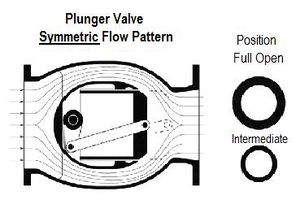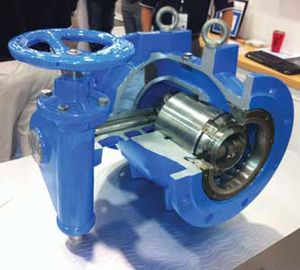Plunger Valves
Plunger Valves are the correct Valves to use whenever pressure heads or flow rates need to be safely and reliably reduced and controlled. They are used for two main tasks:
- By restricting the valve opening a change in flow conditions occurs where both flow velocity through the valve and pressure across the valve increases, resulting in conditions that create cavitation
- To be able to control the pressure and flow precisely and finely, the valve's flow control characteristics must be as linear as possible over the whole opening range.
Butterfly Valves and Gate Valves, due to their design as isolation or, open or closed Valves, are not suitable for continuous use as a variable flow control valve.
Principle of the plunger valve
Typically the change in cross section, of any valve, is made to adjust line pressure or flow rate. Control Valves such as gate valves, or other types of control valves, have an inherent asymmetrical cross section which cannot provide a linear control curve over their respective control range. The plunger valve features a ring shaped symmetrical cross section that enables a linear control curve over the entire control range. Initially the cross-section is steadily reduced from the inlet up to the cylinder seal ring and the flow is guided along in a geometrically optimized shape on between the valve bore and teardrop shaped internal body. A sliding piston is axially guided inside the teardrop shaped internal body to allow for flexible and precise changes of the flow cross-section. The piston's linear movement results from conversion of the rotary movement of the actuator shaft by the internal slider crank mechanism and ensures a well defined ring-shaped cross- section in every position.
Depending on the intended use, various control inserts are mounted on the piston, which split the flow into individual flow streams for conversion of the energy. These flow streams do not hit each other until they reach the middle of the valve or pipe, which reliably prevents cavitation damage to the valve. The design of the plunger valves provides a ring-shaped cross-section in every piston position. The result is safe, reliable energy conversion in the middle of the flow stream, which significantly minimises any effects of cavitation.

